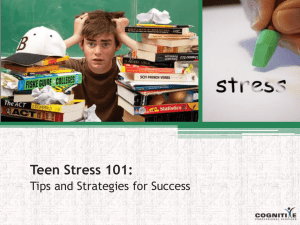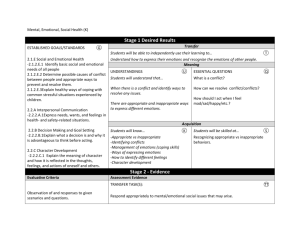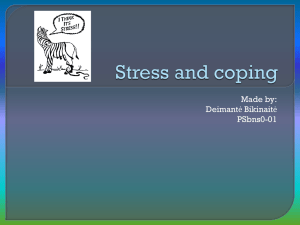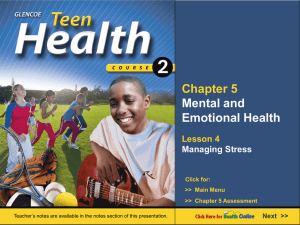Stress Among College Students - Rowan University
advertisement
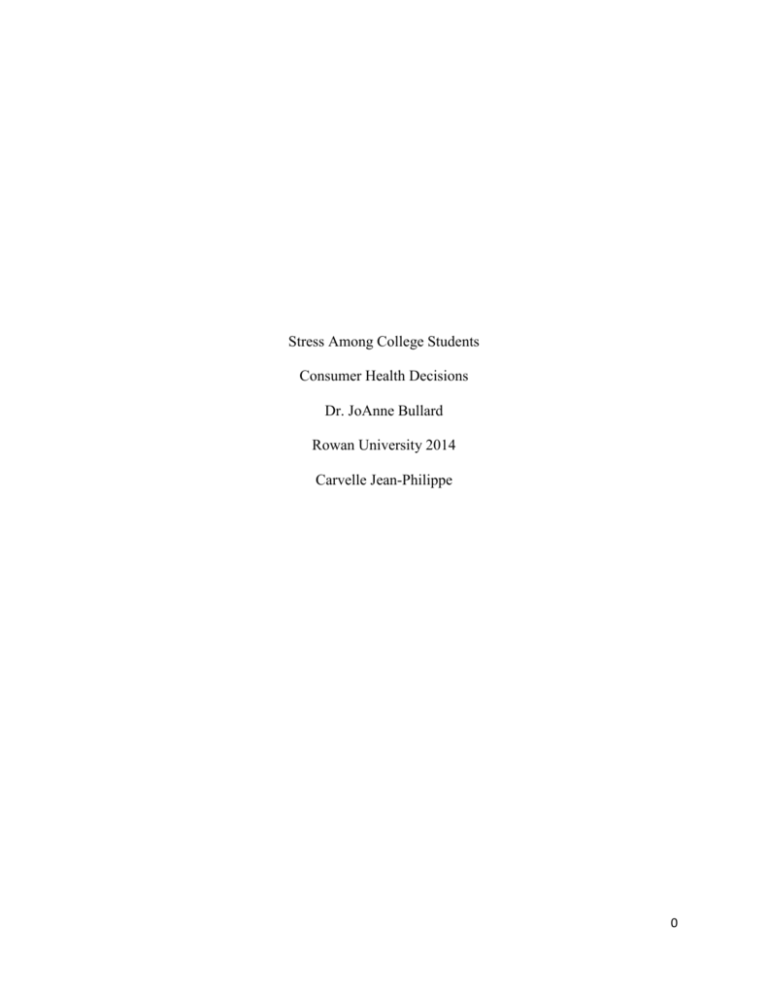
Stress Among College Students Consumer Health Decisions Dr. JoAnne Bullard Rowan University 2014 Carvelle Jean-Philippe 0 Stress Among College Students Introduction: While some people remember college as the best time of their lives, it is also some of the most stressful times. Students are challenged with the transition into college; from being at home with less homework, to now being in college where you are expected to carry a way difficult workload in a faster pace environment with little to no supervision. Stress has become a growing issue for college students as they try to cope with academics, social, and personal challenges (Bland, 2012). When college students emerge into adulthood, they are able to focus on developing autonomy, a purpose, and their identity which can result to stress. The inability or lack of knowledge for these students to cope with stress has caused a negative impact on their health (Bland, 2012). Some college students resort to smoking, eating disorders, depression, substance abuse, etc. This also may cause dropping out of college. With this research, one can focus on the main stressors in college students and obtain positive coping mechanisms to deal with those stressors. Research Question: What do college students believe causes their stress? What is reported as the most common stressors among students and why? What can be done to reduce college students’ stress levels? Significance of the Problem: This research study is important because the rate of college drop outs is slowly increasing. The purpose of this study is to determine the source of these stressors and to provide these college students with effective tools that will reduce stress levels when present and also give them the strategies of effective coping mechanisms. Doing this may possibly decrease the amount of college drop outs throughout the years. Additionally, this will help college students become overall healthier mentally, emotionally, and physically. 1 Review of Literature: McGrath (1970) defined stress as a substantial imbalance between environmental demand and the response capability of the focal organism (Baqutayan, 2012). Kaplan (1983) defined stress as subject's inability to forestall diminish perception, recall, anticipation, and imagination of disvalued circumstances, those that in reality or fantasy signify great and/or increased distance from desirable (valued) experiential states, and consequently, evoke a need to approximate the valued states (Baqutayan, 2012). When students make the transition from high school to college they face challenges associated with adjusting to university life. While many students are able to make the transition perfectly with success, other students tend to experience a great deal of difficulty. Some people remember college as the best time of their lives with little worries and responsibilities; some do not have that luxury. Some college students remember those college years as some of the most stressful times. Students are challenged with the transition into college; from being at home with less homework, to now being in college where you are expected to carry a way difficult workload in a faster pace environment with little to no supervision. Stress has become a growing issue for college students as they try to cope with academics, social, and personal challenges (Bland, 2012). When college students emerge into adulthood, they are able to focus on developing autonomy, a purpose, and their identity which can result to stress. The inability or lack of knowledge for these students to cope with stress has caused a negative impact on their health (Bland, 2012). Some college students resort to smoking, eating disorders, depression, substance abuse, etc. to help reduce their levels of stress not knowing that this may increase the stress levels. This also may cause dropping out of college. With this research, one can focus on the main stressors in college students and obtain positive coping mechanisms to deal with those stressors. Coping with stress 2 has been identified as a high-priority issue in the Healthy Campus initiatives of the American College Health Association (Oman, 2008). Research shows that stressors do not cause anxiety or tension by themselves. Instead, stress results from the interaction between stressors and the individual’s perception and reaction to those stressors. The amount of stress experienced may be influenced by the individual’s ability to effectively cope with stressful events and situations. If stress is not dealt with effectively, feelings of loneliness and nervousness as well as sleeplessness and excessive worrying may result (Krishnan, 2012). With this knowledge it is important to create programs for college students with stress. Creating these programs will increase the success rate of students in college. The stress to do well on weekly papers and tests, to earn good grades, to earn a degree are just a few stressors college students encounter (Krishnan, 2012). Other potential stressors may include unclear assignments, excessive homework, uncomfortable classrooms; the list goes on. With all these stressors, college students must also juggle relationships with family and friends. Studies show that gender also might play a role in stress. Men report an increase in activity level in response to the stress and women report symptoms of depression and anxiety and were more apt to express their feelings (Goldman, 1997). Females may also be more prone to reporting stress than males (Weinstein, 2009). Methods: Twenty Rowan University students will randomly be chosen for this research. No specific age or category (i.e. athletes, commuters, club members, etc.), however, there will be roughly around an even amount of males and females. A survey has been created and will be given out randomly and collected for research. All surveys will be done and collected right after spring break. It is expected for college students to reveal the high level of stress with classes and 3 trying to maintain a social life. Many college students have jobs or are active in extracurricular activities causing them to also have higher levels of stress. 4 STRESS SURVEY My name is Carvelle Jean-Philippe; I am doing an anonymous research study on stress among college students for my class. I would appreciate it if you filled out this survey as honest as possible. Thank you for your time. Part 1 What year in college are you currently in? Freshman (1 year) Sophomore (2 year) Junior (3 year) Senior (4 year) 5 or more years Graduate Student How many credits are you taking this semester? Under 12 More than 12 less than 15 More than 15 less than 19 Gender? Male Female Part 2 Sources of Stress No Stress Slight Stress Average Above Average High Stress Education Test/Exams Papers Workload Homework Classes Grades Living on campus (Roommates/Dorm?) Rate your level of Educational Stressor Extracurricular Activities Sports Clubs Volunteer Rate your level of Extracurricular Stressors Personal Life Friends Family Health Relationships with Significant Other Living arrangement Busy Schedule Recent death of someone close (Family/Friend?) Rate your level of Personal Stressors Employment; Full-time and Part-times (If not employed, go to part 3) Finances Co-workers Management 5 Customers Rate your level of Employment Stressors Part 3 How do you feel at your present level of stress? (Circle all that apply) Hostile Loss of appetite Panic Increase of appetite Irritable Headache Worry Upset stomach/Nausea Anxious Diarrhea Tired Insomnia Emotional No symptoms How do you deal with stress? (Circle all that apply) Exercise Read Sleep Drink alcohol Work Drugs (Advil, Tylenol, etc.) Not eat/dieting Illegal Drugs (Marijuana etc.) Listen to music Hobbies (Draw, act, etc.) Eat more Smoking Talk to friends or family Natural remedies (Candles, Tea, etc.) Nothing in particular Others not listed Part 4 Are you comfortable with your present level of stress? Not at all Somewhat comfortable Neutral Very comfortable How successful are your current coping methods? Not at all Somewhat successful Neutral Very successful Thank you for your time. 6 Results: Out of the study conducted, ten females and ten males were randomly chosen. Out of the ten females, three were sophomores (in their second year), while the remaining seven were juniors (in their third year). Every female reported that they had some form of educational stressors. The females that had more than twelve credits had average or more stress towards school. They reported that the tests, exams, workload, and the struggle to maintain good grades are what provided most of their stress. Many females were not involved in extracurricular activities and the ones that were involved report their stress as average. Only two of the females, reported that they had high stress in clubs, sport teams, and volunteer work. In their personal lives, females reported to have average or less stress. The stress that they did report was because of their family, busy schedule or relationship with their significant others. The females that did report having employment stressors were the same ones who reported had busy schedules and were taking more than fifteen credits. They reported in having above average stress with their finances. Two females reported in not having jobs. Out of the ten males surveyed, four were juniors (in their third year), three were sophomores (in their second year), and three were seniors (in their fourth year). For males, classes, workload, and the need to maintain good grades were their main educational stressors. They all reported to having no stress to above average stress with education. Eight out of ten males reported to be taking more than twelve credits but less than fifteen credits this past semester. Males reported to barely have any stress in extracurricular activities. However, in their personal lives, they reported to have higher stressors than females. Males reported they had above average or high stress with family, relationships with significant others, busy schedules, and two out of ten males reported to have high stress within a recent death of a friend or family member. 7 Three males were not employed and two men reported having above average stress within their employment. They remaining men had average or less stress in employment. Education 11% 17% No Stress Slight Stress How Stressful No Stress Slight Stress Average Above Average High Stress # Of Students How Stressful No Stress Slight Stress Average Above Average High Stress # Of Students 0 3 7 6 2 Average 33% Above Average 39% High Stress Employment 7% 6% 20% No Stress Slight Stress 3 0 10 1 1 Average Above Average High Stress 67% 8 Extracurricular Activities 11% No Stress 10% Slight Stress 5% Average 53% 21% How Stressful No Stress Slight Stress Average Above Average High Stress # Of Students 10 4 1 2 2 Above Average High Stress Personal Life 7% 20% No Stress Slight Stress Average 27% 46% How Stressful No Stress Slight Stress Average Above Average High Stress # Of Students 1 7 4 3 0 Above Average High Stress 9 Both males and females felt the same way about their present stress levels. Ten out of twenty participants felt worried. Nine out of twenty participants were anxious and had headaches. Six students would become emotional. Five students would become irritable. And at a shocking fourteen students out of twenty would be tired. For their coping methods, it looked like almost every student did some sort of exercise, seventeen out of twenty. Fifteen students talk to their friends or family, and fourteen students claimed to listen to music to help cope with their stress. Eleven students use sleeping to cope with their stress and six students drink alcohol. A hand full of students used drugs, illegal drugs, work, hobbies, or reading to cope with their stress. One student was not at all comfortable with her present level of stress, six students were somewhat successful with their present level of stress, and nine of the students were neutral at their present level of stress, while only three students felt very comfortable at their present level of stress. Coping Mechanisms Feelings Worry Anxious Tired # Of Students 10 9 14 Headaches 9 Emotional Irritable Hostile Loss of Appetite Upset stomach/ Nausea Insomnia 6 5 2 1 1 3 # Of Students Exercise Talk to friends or family 17 Listen to music 14 Sleep 11 15 Alcohol Drugs (Advil, Tylenol, etc.) 6 Work 3 Hobbies 3 Illegal Drugs 3 Read 4 Smoking 3 Natural Remedies 2 Eat more 2 3 10 Discussion: From the research and surveys collected, it appears though education and employment are the top stressors in college students lives. Students that did not have jobs claimed the next stressor was their personal lives. Not many students believe that the extracurricular activities caused stress in their lives. In my opinion, I believe the extracurricular activities, helped the students cope with stress. Almost all students used exercise to cope with stress. Majority of the students surveyed were on sport teams. Exercise helped them channel that stress and perform well on the fields, courts, or tracks. Students also used talking to their friends or family to help them cope with stress. Talking to someone is a great way to release stress because you do not keep everything balled up inside. When you say out loud what is on your mind, a lot of times it does not seem as bad as you thought. Also, friends or family can help give you a better way to organize and plan your thoughts. Some of the students that reported to exercise and talk to their friends or family were neutral or very comfortable with their present level of stress. Students used music, sleeping, or alcohol I feel as a gate way away from stressors. Just something to do in the mean time to not think of the responsibilities they have until the song is over, they wake up, or they are no longer drunk. There was a hand full of students that used drugs, illegal drugs, or smoking as ways to cope with stress. This is very harmful and majority of the time leads to college drop outs or very serious injuries. The one student that did not feel at all comfortable with her present level of stress, claimed to do drugs and illegal drugs. Drugs that are becoming very common amongst college students are Adderall and Ritalin. These drugs are believed to help healthy students get a leg up in school, by improving focus, concentration and memory. These drugs can however become very addicting and take a turn for the worst. Some students also use illegal drugs such as 11 Marijuana to help with their stressors. With Marijuana, students feel this carefree attitude that helps them feel careless to their stressors. This also can have very harmful effects. It would be a good idea to start a program for students with a lot of stressors. In the program, there can be positive ways to cope with stressors and maybe even help students get rid of some of those stressors. Schools are becoming more difficult and the future generations of students are having more responsibilities than the previous generations. Also they are expected to perform better and be more intelligent, that alone causes major stress in students. If I could redo my research study, there are a few things I would change to have better and more accurate results. To begin with, I would rephrase certain things on the survey. Some students were confused as to what was being asked and would ask me what the question meant. I would also make sure each student filled out every area of the survey before giving it back to me. Some students left areas blank decreasing the accuracy of the information conducted. It would have been a good idea to also survey more students throughout the semester, but due to time, that was not possible. Overall, I believe the information collected and conducted was done well and pretty accurately. 12 Works Cited Baqutayan, S. M. S., & Mai, M. M. (2012). Stress, Strain, and Coping Mechanisms: An Experimental Study of Fresh College Students. Academy of Educational Leadership Journal, 16(1), 19-30. Bland, H. W., P.H.D., Melton, B. F., E.D.D., Welle, P., S.B., & Bigham, Lauren,M.S., E.D.S. (2012). Stress Tolerance: New Challenged for Millennial College Students. College Student Journal, 46(2), 362-375. Goldman, C. S., & Wong, E. H. (1997). Stress and the college student. Education, 117(4), 604610+. Krishnan, L., & Sequeira, A. H. (2012). Stress among college students and how to combat it. Rochester: Social Science Research Network. Oman, D., PhD., Shapiro, S. L., PhD., Thoresen, C. E., PhD., Plante, T. G., PhD., & Flinders, T., B.A. (2008). Meditation lowers stress and supports forgiveness among college students: A randomized controlled trial. Journal of American College Health, 56(5), 569-78. Weinstein, L., & Laverghetta, A. (2009). College Student Stress and Satisfaction with Life. College Student Journal, 43(4), 1161-1162. 13




